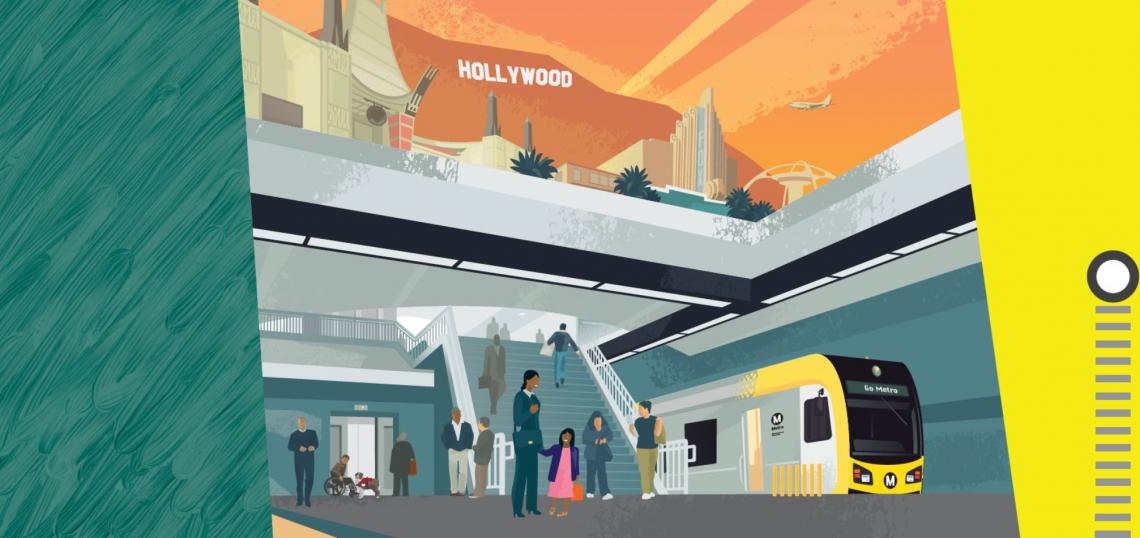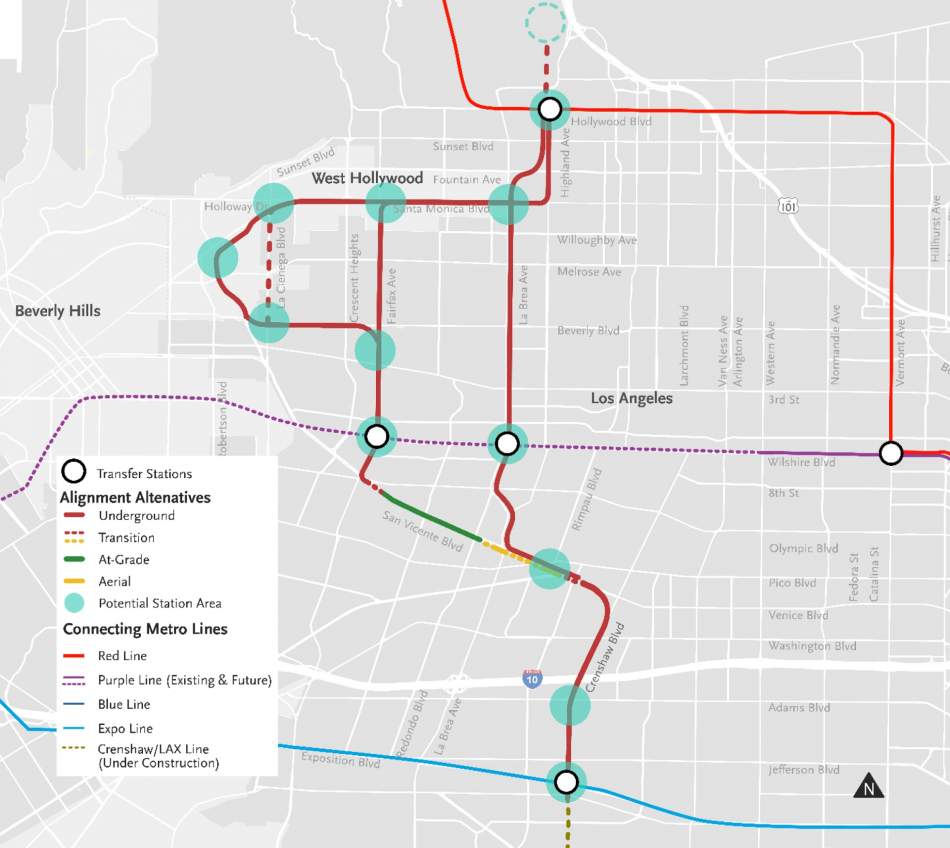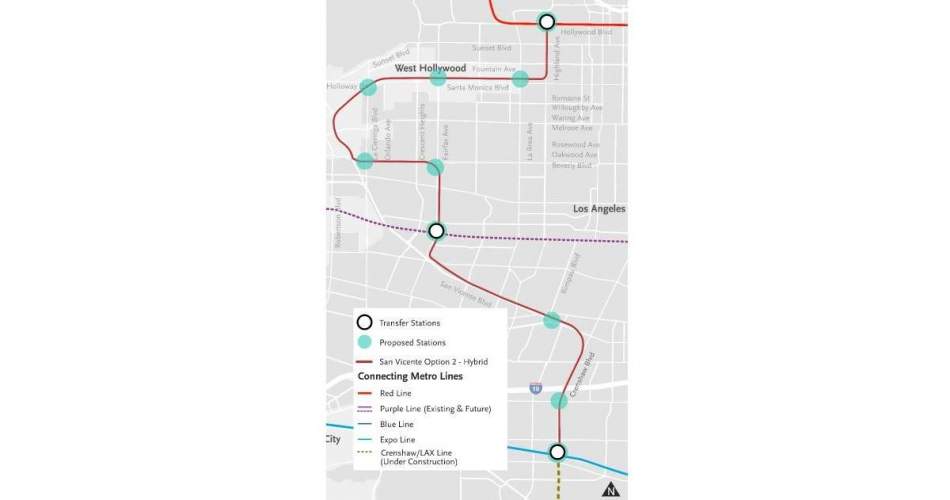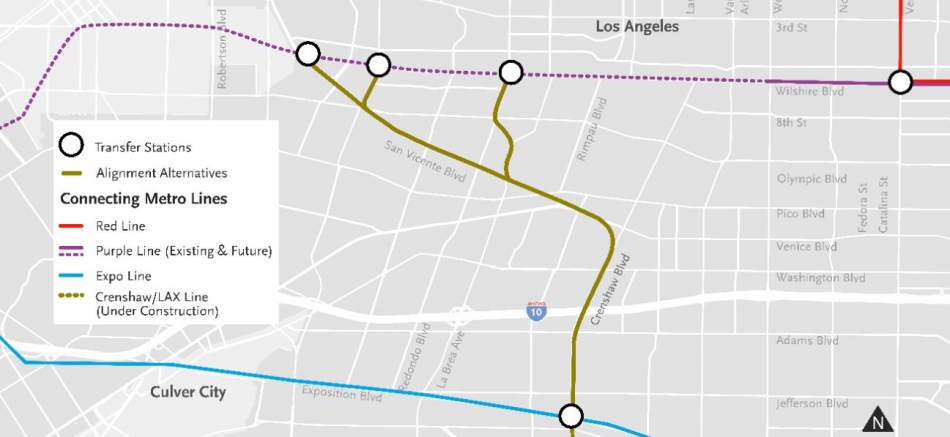Repeated delays have pushed the anticipated opening date of Metro's Crenshaw/LAX Line back to 2021. But while the 8.5-mile light rail line's debut may remain on the horizon, transportation officials are now considering which path the train should take on its voyage north to Hollywood.
Later this month, the Metro Board of Directors is scheduled to vote to initiate an environmental impact report for the proposed extension, which was allocated $2.3 billion under the 2016 Measure M expenditure plan.
Drawing on recommendations from a report submitted by engineering firm AECOM, the environmental study will consider three potential alignments (La Brea, Fairfax, and San Vicente Hybrid Option 2), discarding an earlier concept which would have routed trains east toward Koreatown. Instead, each of the proposed options call for the Crenshaw Line to run through Mid-Wilshire and West Hollywood toward a new terminus at Hollywood/Highland Station - and potentially the Hollywood Bowl.
La Brea
La Brea, the most direct route toward Hollywood, would see trains continuing north under Crenshaw until veering west at Venice Boulevard. The route would once again turn north at La Brea Avenue, proceeding to the new terminus in Hollywood.
Fairfax
Under the Fairfax alternative, the Crenshaw Line would transition to aerial tracks along Venice Boulevard before descending to an at-grade alignment within the median of San Vicente Boulevard. When approaching Fairfax Avenue, tracks would again descend below-grade and continue north as a subway through the Beverly Grove neighborhood. The alignment would then turn east at Santa Monica Boulevard to serve the City of West Hollywood, and then veer north again at Highland Avenue.
San Vicente Alternative Design Option 2 - Hybrid
The hybrid alignment, which emerged in Fall 2019 following a series of community outreach meetings, calls for a meandering route which would serve several activity hubs in Beverly Grove and West Hollywood - including the Grove and the Farmers Market, CBS Television City, the Beverly Center, Cedars-Sinai Medical Center, and the Pacific Design Center.
After proceeding on the same path as the Fairfax alternative, the alignment would turn west at Beverly Boulevard and gradualling curve north onto San Vicente, eventually circling back east as a subway beneath Santa Monica Boulevard. The alignment would eventually return to the same path as the Fairfax alternative, traveling north on Highland toward its ultimate terminus in Hollywood.
All project alternatives are anticipated to generate approximately 90,000 daily passengers - roughly 20,000 of which would be new transit users. However, the difference in the total distance of the three options results in starkly different expectations for speed and cost.
The La Brea alternative, at just 6.3 miles, would take passengers from Expo/Crenshaw Station to Hollywood/Highland Station in just 12.4 minutes. Its total price tag could range between $3 billion and $4.4 billion.
Fairfax, which would require 8.0 miles of new guideway, could ferry passengers between the same stations in roughly 15.7 minutes. Its expected cost is also significantly higher - estimates range from as low as $4.7 billion to as high as $5.3 billion.
The winding hybrid alternative, at 9.9 miles in length, would offer a 20.6-minute trip between Expo/Crenshaw and Hollywood/Highland. Its anticipated price tag far outstrips its counterparts, ranging from $5.5 billion to $6.5 billion.
The cost of the Crenshaw/LAX Line poses a significant challenge to Metro, which has allocated $2.3 billion in local tax revenue for construction of project. However, breaking the project into phases could potentially place at least a portion of the northern extension within reach. The AECOM report notes that one potential option is an initial operating segment terminating at Wilshire Boulevard, creating a new connection between Metros D and E Lines. Service to Wilshire could generate as many as 50,000 daily trips, although the cost of a fully-underground alignment would exceed the funding available through Measure M.
The City of West Hollywood's push to bring the Crenshaw/LAX Line through its borders also serves as an extenuating factor for Metro - though one which offers potential financial benefits.
Through a mix of local tax revenue and a proposed enhanced infrastructure financing district (EIFD), West Hollywood has proposed contributing more than $1 billion toward the construction of the Crenshaw Line extension, with a strong preference for accelerating its scheduled opening date of 2047. However, the full benefit of the proposed EIFD could only be realized under the hybrid alternative - by far the slowest and most costly option under consideration.
- Crenshaw Line (Urbanize LA)









